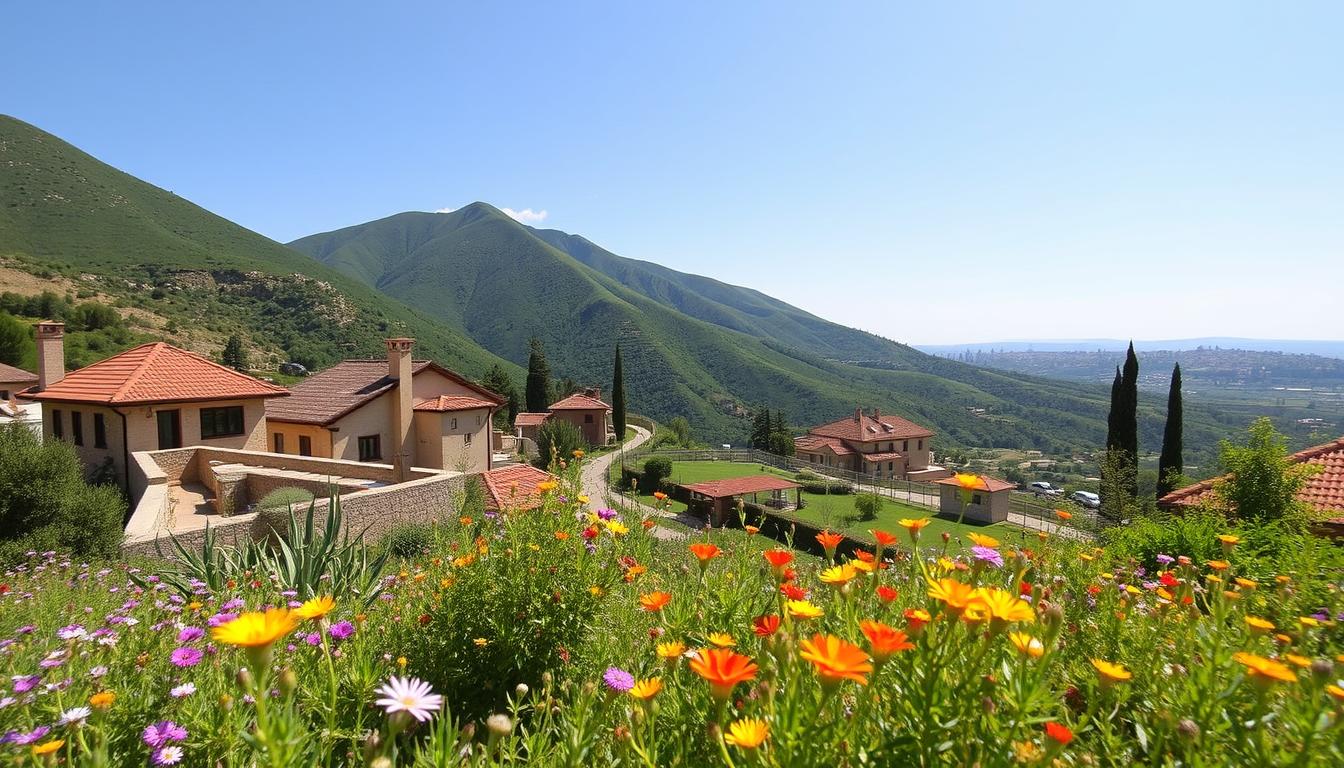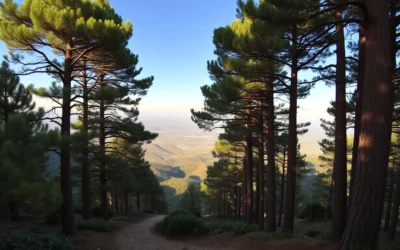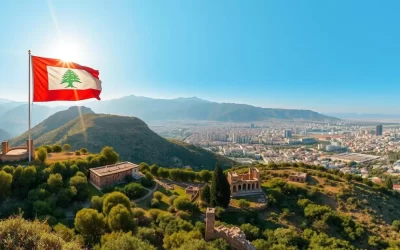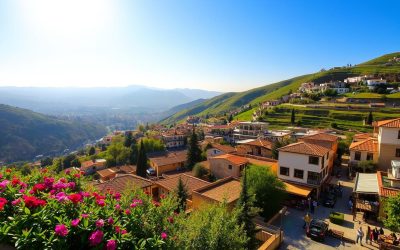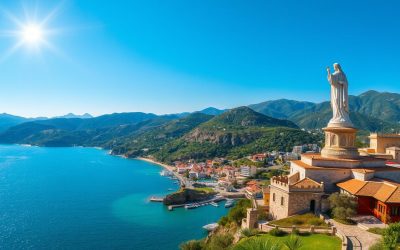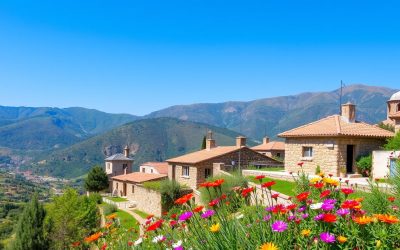The Chouf district is in the heart of Lebanon’s mountains. It’s a mix of history, nature, and culture. But what makes it special? What secrets are hidden for those who explore more?
Get ready to find the best of Chouf. Discover adventures you’ll never forget.
Key Takeaways
- Discover the rich Ottoman heritage and cultural significance of the Chouf region
- Explore the majestic Beiteddine Palace, a stunning historical landmark
- Immerse yourself in the natural beauty of the Chouf Biosphere Reserve and its ancient cedar forests
- Step back in time in the charming village of Deir El Qamar, with its traditional architecture
- Marvel at the unique Moussa Castle, a one-of-a-kind work of art and architecture
Discovering the Historical Charm of Chouf District
The Chouf district is in the heart of Lebanon. It has a rich mix of Ottoman architecture and historical sites. These sites give a glimpse into Lebanon’s cultural heritage.
Places like Deir El Qamar show off traditional houses and narrow lanes. The region is full of museums and heritage sites. It’s a key part of Lebanese history.
The Rich Ottoman Heritage
The Chouf district’s Ottoman legacy is clear in its architecture. Deir El Qamar, the former capital, is a stunning example. It has well-preserved traditional houses and fountains.
Visitors can walk through the town’s courtyards. They can see the detailed houses and fountains. These have lasted for centuries.
Cultural Significance Through the Ages
The Chouf district has always been culturally important. It has many museums and historical sites. These reflect its varied past.
From grand palaces to simple homes, each tells a story. Exploring these sites lets visitors dive into Lebanese heritage.
Modern-Day Preservation Efforts
Recently, efforts have been made to keep the Chouf district’s charm. Many projects aim to protect its Ottoman architecture and cultural sites. This ensures its legacy is shared with everyone.
Thanks to these efforts, the Chouf district is well-preserved. It offers a unique look into Lebanon’s history.
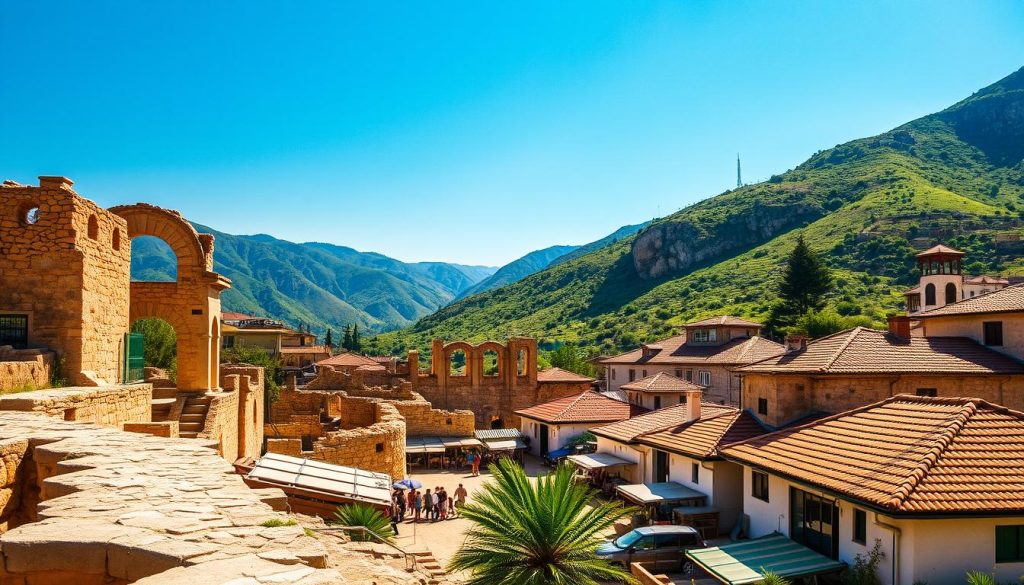
“The Chouf district is a testament to the enduring spirit of Lebanese culture, where the past and present seamlessly converge to create a truly captivating experience.”
Exploring the Majestic Beiteddine Palace
The Beiteddine Palace is a gem in Lebanon’s Chouf region, just 30 minutes from Beirut by car. Built from 1788 to 1818 by Emir Bashir Shihab II, it’s a stunning example of Ottoman architecture. It also highlights the area’s rich cultural history.
Approaching the palace, you’ll be amazed by its courtyards, mosaics, and views. The complex has gardens, hammams, and private apartments. These offer a peek into the lavish lives of the past.
Now, the palace is the Lebanese President’s summer home and hosts the Beiteddine Art Festival. This festival is a major cultural event in the Middle East. You can take guided tours to learn more about its history and architecture.
| Transportation Options | Cost | Travel Time |
|---|---|---|
| Car from Beirut | Around 30 minutes | – |
| Public transportation from Beirut | 10,000 to 15,000 Lebanese pounds | 1 to 1.5 hours |
| Walking from the taxi drop-off point | – | Within walking distance |
The Beiteddine Palace is a true architectural wonder. It showcases the Ottoman architecture and Lebanese historical sites of the area. Whether you love history or just want to see something amazing, visiting the Beiteddine Palace is unforgettable.
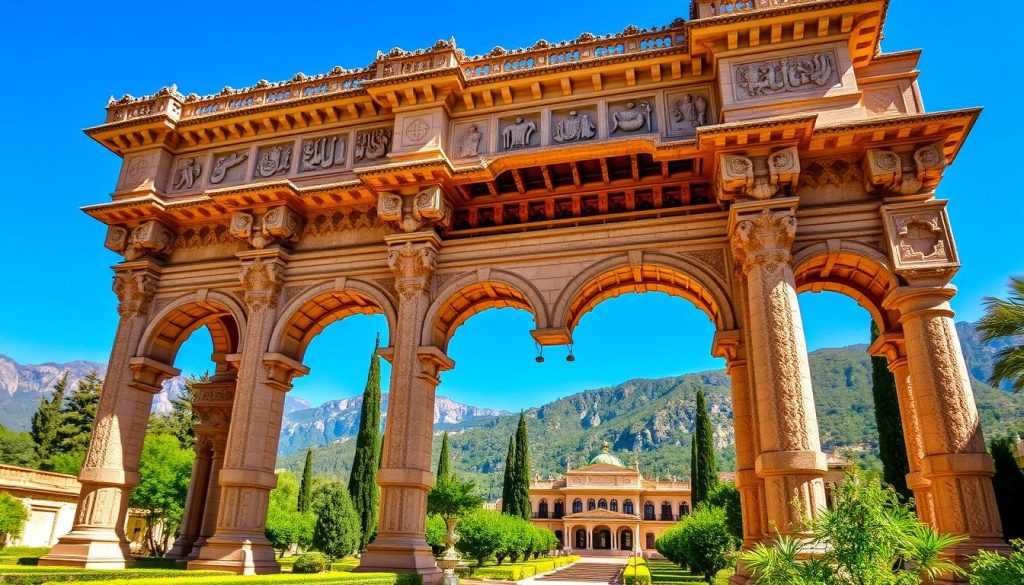
“The Beiteddine Palace is a true testament to the enduring legacy of Lebanon’s cultural and architectural heritage.”
The Natural Wonder of Chouf Biosphere Reserve
In the heart of Lebanon’s Chouf region lies the Shouf Biosphere Reserve. It’s a natural wonder covering 50,000 hectares. This area includes 25% of Lebanon’s cedar trees.
Cedar Forest Conservation
The Shouf Biosphere Reserve has some of the oldest cedar forests. They date back to the third millennium BC. Visitors can see the 2,000-year-old Lamartine cedar tree, a natural treasure.
Hiking Trails and Wildlife
The Shouf Biosphere Reserve hiking trails let you see the area’s beauty. There are trails for everyone, from easy walks to long treks. You can see 25 mammal and 200 bird species.
Seasonal Activities and Best Times to Visit
- Early morning visits are recommended for cooler temperatures and fewer crowds.
- Comfortable hiking shoes are advised due to the rugged terrain.
- In winter, the reserve offers opportunities for snowshoeing and other snow-based activities.
- Visitors are encouraged to bring a picnic to enjoy amidst the Lebanese nature conservation efforts.
The Shouf Biosphere Reserve is a true gem of Lebanese nature conservation. It offers a chance to explore the country’s natural heritage. Whether you want a peaceful retreat or an adventurous outdoor experience, this reserve is a must-see in the Chouf region.
Deir El Qamar: A Journey Through Time
In the heart of Lebanon’s Chouf region, Deir El Qamar awaits. It was once the capital of the Mount Lebanon Emirate. This village is filled with Lebanese traditional architecture and landmarks that share the region’s history.
Walking through Deir El Qamar’s streets, you’ll see Deir El Qamar historic village’s stone houses. Each house has its own charm. The architecture shows the village’s importance, with courtyards and details that take you back in time.
Don’t miss the Fakhreddine Palace, the Silk Khan, and the Younes Maan Palace. These buildings tell the stories of influential figures and times. You can see the interiors, admire the craftsmanship, and imagine the past.
Stay at Beit El Qamar for a full experience. It’s a guesthouse and restaurant that offers traditional Lebanese hospitality and food. It’s set in a beautiful garden, surrounded by Deir El Qamar’s historic architecture.
The Deir El Qamar historic village is perfect for history buffs, architecture lovers, or those seeking peace. It will captivate you and deepen your appreciation for Lebanon’s culture.
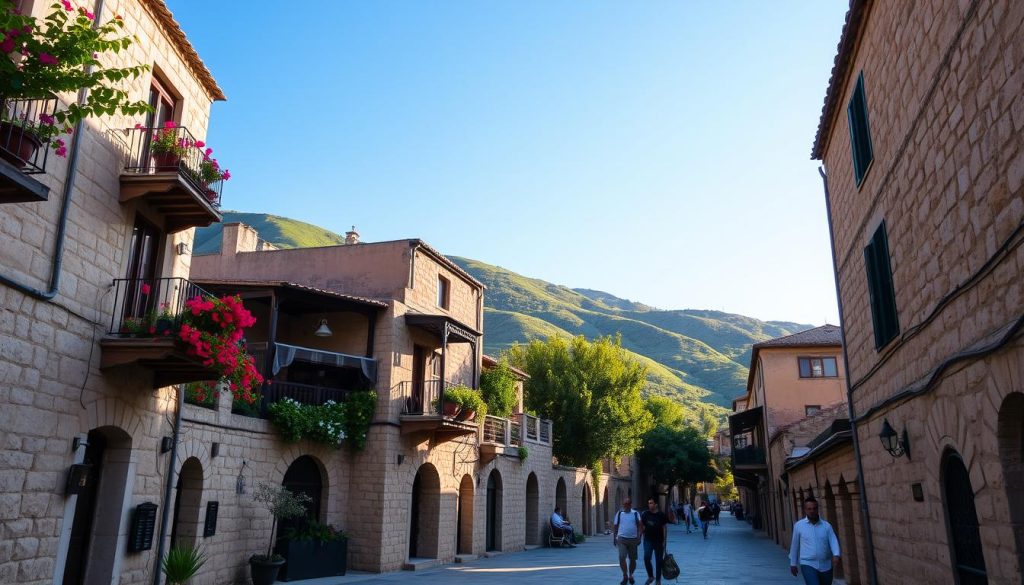
“Deir El Qamar is a living testament to Lebanon’s rich past, where the echoes of history whisper through every cobblestone and architectural masterpiece.”
Moussa Castle: A Dream Built in Stone
Moussa Castle is a gem in the Chouf region of Lebanon. It’s between Deir El Qamar and Beiteddine. This castle took 60 years to build by a man named Moussa. He wanted to create something special, mixing Lebanese design with fantasy.
Architecture and Design Features
The castle’s design shows Moussa’s hard work and creativity. It has towers, archways, and stone carvings that show off Lebanese skill. Its design is striking against the Chouf’s green hills.
Museum Collections and Exhibits
Inside Moussa Castle, you’ll see Lebanon’s history and culture. It has exhibits with artifacts, artwork, and interactive displays. You can see traditional clothes, handicrafts, and ancient relics.
Visitor Experience and Photo Opportunities
Visiting Moussa Castle is an amazing experience. It’s perfect for photographers because of its detailed design and views. You can explore grand halls, lush gardens, or just enjoy the calm. Moussa Castle is a highlight of Chouf attractions.
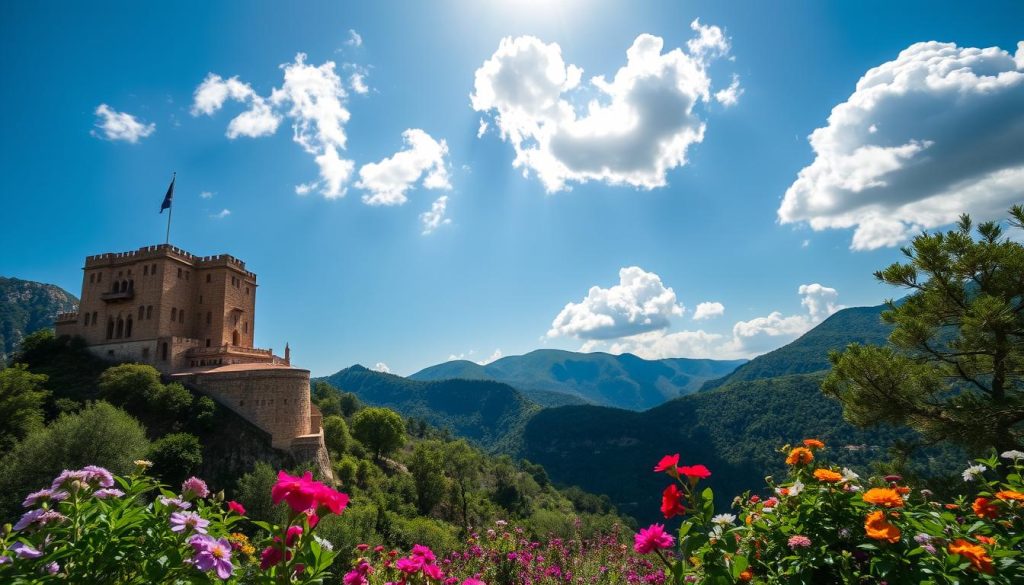
Traditional Lebanese Culinary Experiences
The Chouf region in Lebanon is a feast for the senses. It offers a wide range of traditional Lebanese dishes. From bustling Chouf restaurants to cozy family spots, it’s a journey through Lebanese cuisine for food lovers.
Begin with a Lebanese breakfast. Try manakish, a flatbread with zaatar, cheese, or meat. Add creamy labneh (strained yogurt), homemade jams, and Turkish coffee for a real taste of Lebanon.
For a special meal, visit Shallalat Al Zarka in Baakline. Enjoy your food by a waterfall. Or, dine at Mir Amin Palace in Beiteddine for upscale traditional food experiences in a palace.
For a cozy feel, go to Baytna Restaurant in Barouk. It offers homemade Lebanese dishes with views of the Barouk river. Wine lovers should check out St. Micheal Micro Winery in Maaser El Chouf for local wines and more culinary offerings.
“The flavors of Lebanon are a symphony of spices, herbs, and freshness that dance on your palate, transporting you to the heart of this captivating country.”
These traditional Lebanese culinary experiences let visitors dive into the Chouf region’s rich food heritage. Enjoy the flavors, textures, and colors of this vibrant cuisine. Make unforgettable memories in this enchanting part of Lebanon.
Art and Culture at Atelier Assaf
Atelier Assaf is in the heart of the Chouf region. It celebrates Lebanese art, culture, and the area’s natural beauty. Founded by three brothers, it combines creativity, sustainability, and the Chouf district’s rich heritage.
Sculpture Gardens and Exhibitions
At Atelier Assaf, you can explore the sculpture gardens. They have outdoor installations by local and international artists. The museum inside shows rotating exhibitions of Lebanese art, featuring both new and well-known artists.
Local Artisan Workshops
At Atelier Assaf, you can meet skilled local artisans. They teach traditional crafts like pottery-making and weaving. These workshops let you experience the Chouf cultural attractions firsthand.
Cultural Events Calendar
Summer at Atelier Assaf is filled with cultural events. There are art shows, music, and educational programs. These events offer a deep dive into the region’s art and culture, making Atelier Assaf a top spot for art lovers in Lebanon.
“Atelier Assaf is a true gem, where the beauty of nature and the creativity of the human spirit converge to create an unforgettable experience.”
Natural Wonders: Lakes and Waterfalls
The Chouf region in Lebanon is a natural paradise. It has stunning lakes and waterfalls that invite visitors to explore. Baakline is famous for its blue lakes and waterfalls, now also great places to eat.
Take a hike along the Darb El Naher trail in Jahiliye. You’ll see a beautiful river, waterfalls, lakes, and old bridges. Serjbel offers a peaceful lake and waterfall after a 15-minute hike. The village of Niha has the Fortress of Niha, with amazing views of Marj Besri.
Looking for peace, adventure, or a chance to see Lebanon’s beauty? The Chouf region’s lakes and waterfalls are unforgettable. Start your journey of discovery and make these natural wonders the best part of your trip.
The above is subject to change.
Check back often to TRAVEL.COM for the latest travel tips and deals.
